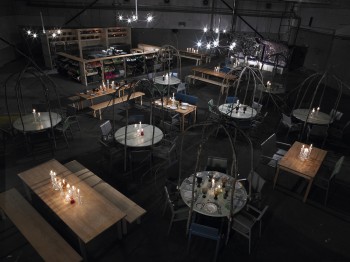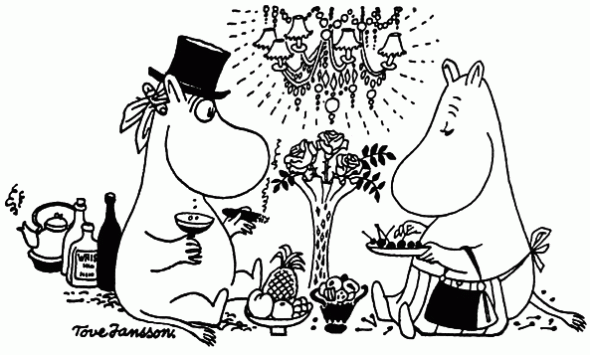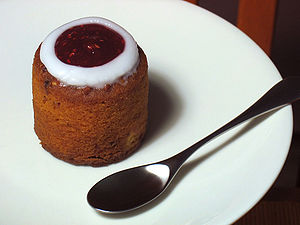Tag: cookery
Pig cheeks and chanterelle dust
21 August 2014 | This 'n' that
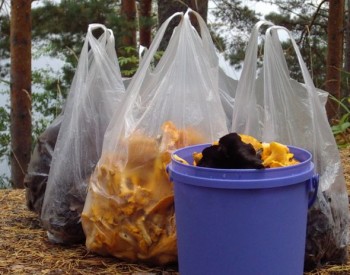
Wild and plentiful: chanterelles, black horns of plenty. Photo: Soila Lehtonen
Pop-up restaurants came into being in Helsinki in 2011: a few times every year any eager amateur cook is able to set up a ‘restaurant’ for one day on a street corner or in a park: citizens are welcome to take their pick, at a modest price.
In a northern city, not exactly suitable for street food trade all year round, in a country where rules of food hygiene are strict, the innovation of the Restaurant Day has been welcomed by the public. The latest event took place on 17 August.
The idea has now spread to at least 60 countries. Foodie culture thrives.
We find an article in The New Yorker by Adam Gopnik, No rules! Is Le Fooding, the French culinary movement, more than a feeling? interesting – according to comments quoted in it, ‘food must belong to its time’, and the traditional French cuisine ‘was caught in a museum culture: the dictatorship of a fossilized idea of gastronomy’.
In the 1960s, ‘nouvelle cuisine’, as opposed to cuisine classique, began to promote lighter, simpler, inventive, technically more advanced cooking. Well – some of us may remember that, at worst, this could also manifest itself in, say, three morsels of some edible substance placed decoratively on a plate topped with three chives: expensive, insubstantially elegant and pretty useless.
Today, Finland, the traditional stronghold of liver casserole, brown sauce and ham-mincemeat-pineapple pizzas (yes), seems to have moved onto a higher level of the culinary art – at least in selected restaurants. In a recent article, Helsinki’s food scene, coming on strong, published in The Washington Post, Tom Sietsema enjoys the pleasure of discovering things Finnish.
He is treated to parsnip leaves turned into ice cream imparting a coconut flavour, crackers made from leek ash and risotto in which ‘tiny green hops and their purple flowers interrupt the beige surface of the bowl, whose rim is dusted with golden chanterelle powder.’
The Executive Chef of Helsinki’s esteemed Savoy restaurant (est. 1937) cooks braised pig cheeks served with rhubarb and spring greens. A hunter-gatherer chef collects wild things: wood sorrel, spruce shoots and orpine and serves them in an omelette, with a drink made of chaga mushrooms (used for making tea; a sort of ‘sterile conk trunk rot of birch’, currently very much in vogue among the most eager of foodies for its medicinal [antioxidant, anti-inflammatory] properties).
It is true that Copenhagen and Stockholm have advanced further on their way to international fame of cuisine, but perhaps Helsinki will follow suit. And people who go out for a meal are no longer expected to settle for morsels with chives on top – food belongs to its time, and time changes food(ies).
A comment on Sietsema’s article claims though that his ‘verbiage’ has ‘nothing to do with what 99.999% of Finns eat! and what 99.99% of Finnish restaurants offer!’
But the truth (we know) is now closer to Sietsema than the commentator: ambitious restaurants may play with golden chanterelle powder, and even if it is not exactly what Finns often have for tea, we believe Finns today are losing interest in cheap chicken slivers in industrial marinade for dinner, and even beginning to accept that greens may not be only for bunnies.
Chanterelles have always been considered as a treat: fresh from the woods, quickly cooked in butter and cream, served with new potatoes and rye bread, or in an omelette: bon appetit (even without orpine)!
3 x Runeberg: poet, cake & prize
5 February 2014 | This 'n' that
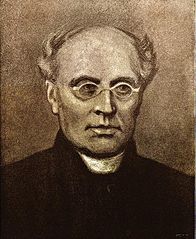
J.L. Runeberg. Painting by Albert Edelfelt, 1893. WIkipedia
Today, the fifth of February, marks the birthday of the poet J.L. Runeberg (1804–1877), writer, among other things, of the words of Finnish national anthem.
Runeberg’s birthday is celebrated among the literary community by the award of the Runeberg Prize for fiction; the winner is announced in Runeberg’s house, in the town of Borgå/Porvoo.
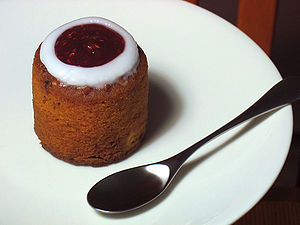
Runeberg’s favourite. Photo: Ville Koistinen
Mrs Runeberg, a mother of seven and also a writer, is said to have baked ‘Runeberg’s cakes’ for her husband, and these cakes are still sold on 5 February. Read more – and even find a recipe for them – by clicking our story Let us eat cake!
The Runeberg Prize 2014, worth €10,000, went to Hannu Raittila and his novel Terminaali (‘Terminal’, Siltala).

Hannu Raittila. Photo: Laura Malmivaara
According to the members of the prize jury – the literary scholar Rita Paqvalen, the author Sari Peltoniemi and the critic and writer Merja Leppälahti – they were unanimous in their decision; however, the winner of the 2013 Finlandia Prize for Fiction, Jokapäiväinen elämämme (‘Our everyday lives’) by Riikka Pelo, was also seriously considered.
Read more about the 2014 Runeberg shortlist In the news.
Christer Lindgren: Stadin klassikot. Maukkainta retroruokaa [City classics. The tastiest retro fare]
18 May 2012 | Mini reviews, Reviews
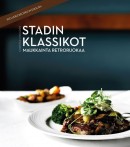 Stadin klassikot. Maukkainta retroruokaa
Stadin klassikot. Maukkainta retroruokaa
[City classics. The tastiest retro fare]
Helsinki: Teos, 2012. 135 p., ill.
ISBN 978-951-851-433-9
€32.90, hardback
Even a small metropolis like Helsinki has a few restaurants that have survived the changes of time by sticking to traditional dishes. This book features Sea Horse, Elite, Kosmos and Kolme Kruunua (‘The Three Crowns’), established in 1934, 1932, 1924 and 1928 respectively. Their interiors – stylish art deco and functionalism – date from the 1920s and 1930s. A Sea Horse specialty, fried Baltic herrings, 16 per portion, delighted trumpetist Dizzy Gillespie so much that he ate his, his Finnish host’s and half of a fellow guest’s. The most popular recipes have been influenced by food cooked to the east, north and west (Russia, Lapland, Sweden) and mainly feature meat, fish, poultry and potatoes – cooked with plenty of butter and cream. These restaurants were – and are – frequented by politicians and artists of various fields, so the recipes include ‘Tauno Palo’s cream onion steaks’ or ‘Cod Mannerheim’. It is unfortunate that only the recipes have been translated, not the little stories about the restaurants, so an English reader has no idea who Tauno Palo was (1908–1982; the Finnish equivalent of Cary Grant). The translations sometimes go amiss: a recipe entitled ‘Sautéed reindeer’ first lists a kilo of ‘sautéed reindeer’, when it should of course list ‘a kilo of sliced reindeer meat’. The photos have been shot in situ, so the dishes look nicely authentic.
HEL YES!
24 September 2010 | This 'n' that
Run that by me again, please?
Oh: HEL is the airport abbreviation of Helsinki, and the second word completes the title given to a pop-up restaurant set up by a team of Finnish designers and chefs in London. It takes place at 1–3 Wenlock Road, London N1, between 15 September and 3 October.
HEL YES! is commissioned and produced by the Finnish Institute in London as part of its Arts & Culture Programme, in anticipation of Helsinki’s role as World Design Capital in 2012.
The restaurant offers inventive Finnish dishes, the dinner service plates are mix ‘n’ match vintage Iittala and the diners sit on Alvar Aalto and Artek’s ‘403’ chairs painted in a new range of colours.
We hear the reservations for dinner are now been fully booked, but coffee and drinks are available in the restaurant, a former depot. See what the press said, here.
Maarit Knuuttila: Kauha ja kynä. Keittokirjojen kulttuurihistoriaa [The ladle and the pen. The cultural history of the cookbook]
24 September 2010 | Mini reviews, Reviews
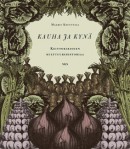 Kauha ja kynä. Keittokirjojen kulttuurihistoriaa
Kauha ja kynä. Keittokirjojen kulttuurihistoriaa
[The ladle and the pen. The cultural history of the cookbook]
Helsinki: SKS (The Finnish Literature Society), 2010. 207 p., ill.
ISBN 978-952-222-187-2
€ 26, hardback
This book by ethnologist Maarit Knuuttila describes the history of European cookbooks, recipes and cooking. Knuuttila familiarises the reader with the earliest documents relating to the preparation of food, which were written by the ancient Greeks and Romans, but of which only a few have been preserved. Instead of haute cuisine the book concentrates on the authors and users of basic Finnish cookery books, and examines how those books reflect the times in which they were written, as well as their significance for women. While the literary high culture of gastronomy has been produced mainly by men, the everyday dishes represented in the basic cookbooks are the work of women. The author discusses the changes in perceptions of the ideal home and health, as well as the ways in which Finnish cookery, housekeeping and food culture have altered during the past hundred years.
Moomin food
19 August 2010 | In the news
A cookbook that introduces Tove Jansson’s famous Moomin family and other characters from the delightful classic stories for children (and adults), with original illustrations and quotations from the Moomin books, has been published in the UK.
Entitled Moomins’ cookbook. An introduction to Finnish cuisine (translated by David Hackston and published by SelfMadeHero), the book was compiled and written by Sami Malila and published in Finnish in 1993 (WSOY).
The Moomins are also currently being celebrated in an exhibition at the Design Shop UK in Edinburgh, entitled ‘And the World Went Mad for Moomins’. The exhibition runs until September 5.
Translations of books by Tove Jansson (1914–2001) have been published in more than 30 languages.
The cookbook offers recipes of healthy porridges and fish dishes, mushrooms and fresh berries, as well as treats like one of the Moomins’ favourites, pancakes (often cooked in the oven) with jam and whipped cream.
And as this is a cookbook for the whole family, Moominpappa’s grog contains no alcohol – but it’s no secret he enjoys a drop of good whisky (see the picture) every now and then, and a good cigar.
Let us eat cake
4 February 2010 | This 'n' that
Here at Books from Finland central we’re celebrating, with the one Finnish literary anniversary that involves its own dedicated cake.
The fifth of February marks the birthday of the poet J.L. Runeberg (1804–1877) – writer, among many other things, of the Finnish national anthem (actually unofficial, as there’s no mention of such a thing in the legislation), which he wrote in Swedish, Vårt land (in Finnish, Maamme). More…
Slowly does it
5 November 2009 | Reviews
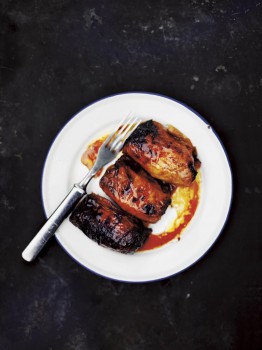
Straight from the oven: cabbage rolls. – Photo: Sami Repo
Mummola
[Grandma’s house]
(food: Hans Välimäki, photographs: Sami Repo, text: Mikko Takala, graphic design: Timo Numminen)
Helsinki: Otava, 2009. 224 p., ill.
ISBN 978-951-1-23930-7
€ 40
How paradoxical: in the past couple of decades, numerous internationally famous gourmet restaurants have sprung up in Finland, and at the same time it’s harder than ever to find ordinary, well-prepared ingredients for cooking at home.
It’s hard to get used to the fact that foods like beef and lamb kidneys, sweetbread, and cheaper cuts for use in stews and soups have made way for cheap Brazilian steaks on special offer, even at the largest stores’ meat counters. There’s no point in looking for whole chickens (and certainly not organic poultry), let alone whole, locally caught fish. The last time I asked at the fish counter of my local market if they might have any salmon heads and bones for chowder, the seller looked for a moment like she might summon security. The consumer wasn’t consulted when ‘taste’ and ‘variety’ were replaced by ‘ease’ and ‘speed’. More…
Food for thought
23 July 2009 | In the news
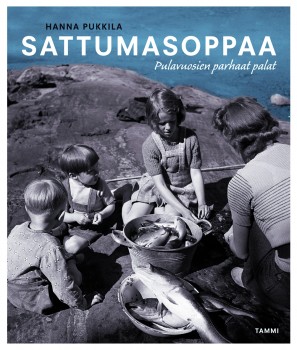
Dinner in a dash: surprise soup?
The flow of cookbooks into bookshops has recently – and universally – slowed down a little, as the internet provides more and more recipes for those wishing to experiment with cuisine.

